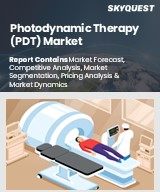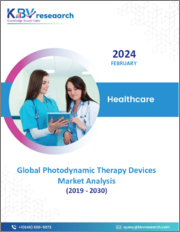
|
시장보고서
상품코드
1447636
광역학적 치료 기기 시장 규모 : 제품별, 용도별, 최종 용도별 및 세계 예측(2024-2032년)Photodynamic Therapy Devices Market Size - By Product (Diode Lasers, Disposable Fiber Optic Light Delivery Devices), Application (Cancer, Actinic Keratosis, Acne, Psoriasis), End-use (Hospitals, Dermatology Clinics) & Global Forecast, 2024 - 2032 |
||||||
세계의 광역학적 치료 기기 시장은 2024-2032년 CAGR 8.3%로 성장합니다. 햇빛 노출과 같은 요인으로 인해 광선각화증은 증가 추세에 있으며, 효과적인 치료에 대한 수요가 증가하고 있습니다. 또한 개선된 광원 및 감광제와 같은 기술 혁신은 광 역학 치료의 효과와 정확성을 향상시키고 있습니다.
이러한 발전에 대응하기 위한 새로운 출시로 인해 시장은 상당한 성장을 이룰 것으로 보입니다. 예를 들어 2023년 12월 Zolar Technologies와 Oral Science는 최신 Photon EXE 연조직 다이오드 레이저를 출시했습니다. 이 새로운 레이저 시스템은 컴팩트하고 휴대가 간편한 디자인을 자랑하며, 대형 터치스크린 제어 패널을 통해 효율성과 편의성을 높인 것이 특징입니다.
광역학적 치료 기기 산업은 제품, 애플리케이션, 최종 용도 및 지역에 따라 분류됩니다.
용도별로는 특히 일사량이 많은 지역에서 광 역학 각화증 유병률이 증가함에 따라 광 역학 각화증 분야 시장 매출은 2032년까지 연평균 8.6%의 성장률을 나타낼 것으로 예상됩니다. 광역학 치료는 부작용이 적고 효과적인 치료법이기 때문에 환자 및 의료 서비스 프로바이더 사이에서 채택이 증가하고 있습니다. 인지도가 높아지고 예방적 피부과 치료를 찾는 사람들이 증가함에 따라 광역학적 치료 기기에 대한 수요는 광 역학 치료를 통한 광선각화증 치료에서 증가할 수 있습니다.
광역학적 치료 기기 시장의 피부과 클리닉 최종 용도 분야는 암성 및 전암성 병변을 포함한 다양한 피부 질환에 대한 피부과 치료를 찾는 개인이 증가함에 따라 2032년까지 7.9%의 연평균 복합 성장률(CAGR)을 나타낼 것으로 예상됩니다. 피부과 클리닉은 효과적이고 부작용이 적은 광역학 요법을 점점 더 많이 채택하고 있으며, 안전하고 효과적인 치료를 원하는 환자들을 끌어들이고 있습니다. 또한 피부 건강과 미용에 대한 관심이 높아지면서 피부과에서 광역학 치료 장비에 대한 수요도 증가할 것으로 보입니다.
아시아태평양의 광역학 치료 기기 산업은 2024-2032년 연평균 8.8%의 연평균 복합 성장률(CAGR)을 나타낼 것으로 예상됩니다. 이는 암 발병률 증가, 의료 인프라의 발전, 혁신적인 의료 기술 채택 증가 등에 기인합니다. 중국, 일본, 인도 등의 국가들은 연구개발에 많은 투자를 하고 있습니다. 급속한 고령화와 광역학 치료의 이점에 대한 인식이 높아짐에 따라 이 지역의 제품 수요는 증가할 것으로 예상됩니다.
목차
제1장 조사 방법과 조사 범위
제2장 주요 요약
제3장 업계 인사이트
- 업계에 대한 영향요인
- 촉진요인
- 피부암의 유병률 상승
- 광역학적 치료 기기의 기술적 진보
- 광역학적 요법에 관한 의식의 향상
- 저침습치료에 대한 선호도의 증가
- 업계의 잠재적 리스크 & 과제
- 광역학 요법 치료의 고비용
- 엄격한 규제 프레임워크
- 촉진요인
- 성장 가능성 분석
- 규제 상황
- 기술적 전망
- Porter의 산업 분석
- PESTEL 분석
제4장 경쟁 구도
- 서론
- 기업 매트릭스 분석
- 기업 점유율 분석
- 경쟁 포지셔닝 매트릭스
- 전략 전망 매트릭스
제5장 시장 추산·예측 : 제품별, 2018-2032년
- 주요 동향
- 다이오드 레이저
- 일회용 광섬유 전송 기기
제6장 시장 추산·예측 : 용도별, 2018-2032년
- 주요 동향
- 암
- 광선성 각화증
- 여드름
- 건선
- 기타 용도
제7장 시장 추산·예측 : 최종사용자별, 2018-2032년
- 주요 동향
- 병원
- 피부과 클리닉
- 기타 최종사용자
제8장 시장 추산·예측 : 지역별, 2018-2032년
- 주요 동향
- 북미
- 미국
- 캐나다
- 유럽
- 독일
- 영국
- 프랑스
- 이탈리아
- 스페인
- 기타 유럽
- 아시아태평양
- 일본
- 중국
- 인도
- 호주
- 한국
- 기타 아시아태평양
- 라틴아메리카
- 브라질
- 멕시코
- 아르헨티나
- 기타 라틴아메리카
- 중동 및 아프리카
- 남아프리카공화국
- 사우디아라비아
- 아랍에미리트
- 기타 중동 및 아프리카
제9장 기업 개요
- Biolitec AG
- Boston Scientific Corporation
- Candela Corporation
- Coherent Corporation
- Cutera Inc.
- Excel Lasers
- IRIDEX Corporation
- Lumibird Medical
- Modulight USA Inc.
- ShangHai Apolo Medical Technology Co.,Ltd
Global Photodynamic Therapy Devices Market will grow at an 8.3% CAGR from 2024 to 2032, fueled by the growing prevalence of actinic keratosis coupled with rapid technological advancements. Actinic keratosis cases are on the rise due to factors like sun exposure, creating a higher demand for effective treatments. Additionally, technological innovations, such as improved light sources and photosensitizers, are enhancing the efficacy and precision of photodynamic therapies.
With new launches for catering to these advancements, the market will experience substantial growth. For instance, in December 2023, Zolar Technologies and Oral Science unveiled the latest Photon EXE soft-tissue diode laser. This new laser system boasts of a compact and portable design, featuring a sizable touchscreen control panel to render enhanced efficiency and convenience.
The photodynamic therapy devices industry is classified based on product, application, end-use, and region.
With respect to application, the market revenue from the actinic keratosis segment will experience 8.6% CAGR up to 2032 due to the rising prevalence of actinic keratosis, especially in regions with high sun exposure. Photodynamic therapy offers an effective treatment option with minimal side effects, driving its adoption among patients and healthcare providers alike. With the growing awareness and more individuals seeking preventative dermatological treatments, the demand for photodynamic therapy devices may rise in actinic keratosis treatment
The dermatology clinics end-use segment in the photodynamic therapy devices market may witness 7.9% CAGR through 2032, propelled by the rising number of individuals seeking dermatological treatments for various skin conditions, including cancerous and precancerous lesions. Dermatology clinics are increasingly adopting photodynamic therapy due to its efficacy and minimal side effects, attracting patients looking for safe and effective treatments. The growing emphasis on skin health and cosmetic procedures will also push the demand for photodynamic therapy devices in dermatology clinics.
Asia Pacific photodynamic therapy devices industry will record an 8.8% CAGR from 2024 to 2032, attributed to the rising cancer prevalence, advancements in healthcare infrastructure, and increased adoption of innovative medical technologies. Countries like China, Japan, and India are showcasing significant investments in research and development. With the burgeoning aging population and the growing awareness of the benefits of photodynamic therapy, the regional product demand is expected to rise.
Table of Contents
Chapter 1 Methodology & Scope
- 1.1 Market scope & definitions
- 1.2 Base estimates & calculations
- 1.3 Data collection
- 1.4 Forecast parameters
- 1.5 Data validation
- 1.6 Data sources
- 1.6.1 Primary
- 1.6.2 Secondary
- 1.6.2.1 Paid sources
- 1.6.2.2 Unpaid sources
Chapter 2 Executive Summary
- 2.1 Industry 360 degree synopsis
Chapter 3 Industry Insights
- 3.1 Industry impact forces
- 3.1.1 Growth drivers
- 3.1.1.1 Rising prevalence of skin cancer
- 3.1.1.2 Technological advancements in photodynamic therapy devices
- 3.1.1.3 Increasing awareness regarding photodynamic therapy
- 3.1.1.4 Growing preference for minimally invasive procedures
- 3.1.2 Industry pitfalls & challenges
- 3.1.2.1 High cost of photodynamic therapy treatment
- 3.1.2.2 Stringent regulatory framework
- 3.1.1 Growth drivers
- 3.2 Growth potential analysis
- 3.3 Regulatory landscape
- 3.4 Technological landscape
- 3.5 Porter's analysis
- 3.5.1 Supplier power
- 3.5.2 Buyer power
- 3.5.3 Threat of new entrants
- 3.5.4 Threat of substitutes
- 3.5.5 Industry rivalry
- 3.6 PESTEL analysis
Chapter 4 Competitive Landscape, 2023
- 4.1 Introduction
- 4.2 Company matrix analysis
- 4.3 Company market share analysis
- 4.4 Competitive positioning matrix
- 4.5 Strategic outlook matrix
Chapter 5 Market Estimates and Forecast, By Product, 2018 - 2032 ($ Mn)
- 5.1 Key trends
- 5.2 Diode lasers
- 5.3 Disposable fiber optic light delivery devices
Chapter 6 Market Estimates and Forecast, By Application, 2018 - 2032 ($ Mn)
- 6.1 Key trends
- 6.2 Cancer
- 6.3 Actinic keratosis
- 6.4 Acne
- 6.5 Psoriasis
- 6.6 Other applications
Chapter 7 Market Estimates and Forecast, By End-Use, 2018 - 2032 ($ Mn)
- 7.1 Key trends
- 7.2 Hospitals
- 7.3 Dermatology clinics
- 7.4 Other end-users
Chapter 8 Market Estimates and Forecast, By Region, 2018 - 2032 ($ Mn)
- 8.1 Key trends
- 8.2 North America
- 8.2.1 U.S.
- 8.2.2 Canada
- 8.3 Europe
- 8.3.1 Germany
- 8.3.2 UK
- 8.3.3 France
- 8.3.4 Italy
- 8.3.5 Spain
- 8.3.6 Rest of Europe
- 8.4 Asia Pacific
- 8.4.1 Japan
- 8.4.2 China
- 8.4.3 India
- 8.4.4 Australia
- 8.4.5 South Korea
- 8.4.6 Rest of Asia Pacific
- 8.5 Latin America
- 8.5.1 Brazil
- 8.5.2 Mexico
- 8.5.3 Argentina
- 8.5.4 Rest of Latin America
- 8.6 Middle East and Africa
- 8.6.1 South Africa
- 8.6.2 Saudi Arabia
- 8.6.3 UAE
- 8.6.4 Rest of Middle East and Africa
Chapter 9 Company Profiles
- 9.1 Biolitec AG
- 9.2 Boston Scientific Corporation
- 9.3 Candela Corporation
- 9.4 Coherent Corporation
- 9.5 Cutera Inc.
- 9.6 Excel Lasers
- 9.7 IRIDEX Corporation
- 9.8 Lumibird Medical
- 9.9 Modulight USA Inc.
- 9.10 ShangHai Apolo Medical Technology Co.,Ltd



















